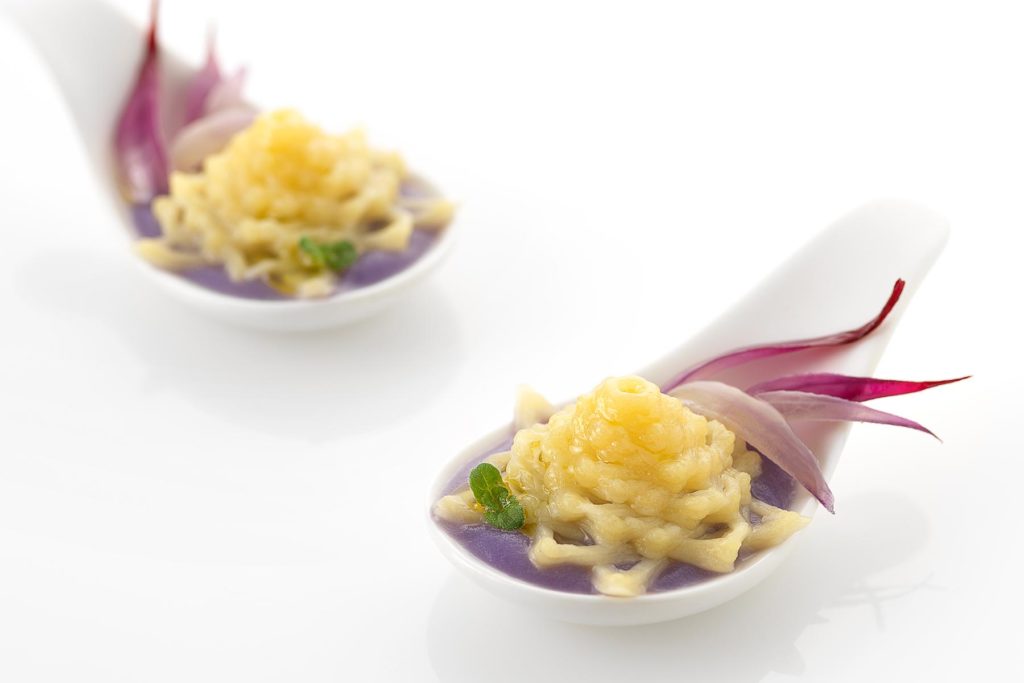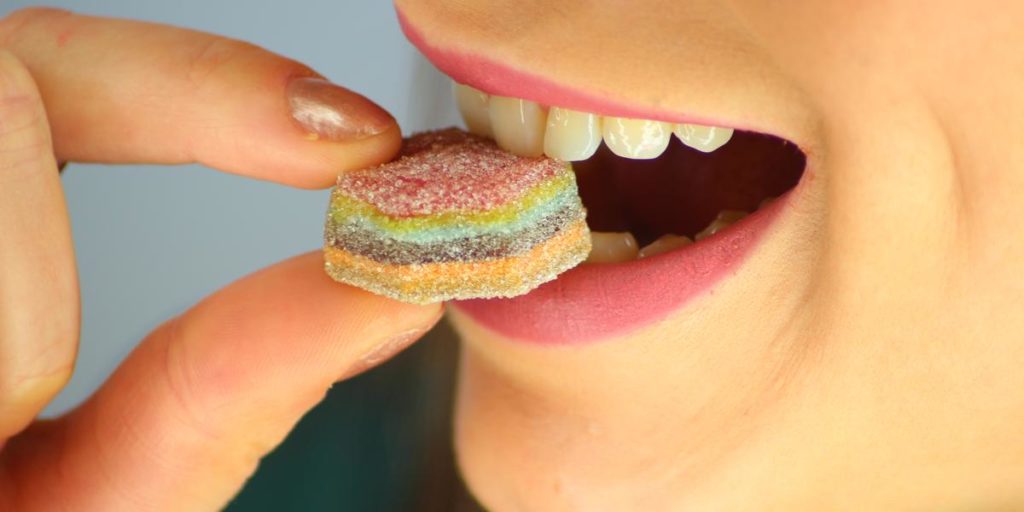Ok, so food printing is a thing, but why is it a thing and will it become more of a thing in the future? To answer these semi-coherent questions, we thought about looking at some of the initiatives from larger companies that have been experimenting with 3D printing over the years. For instance, Barilla made headlines for its 3D printed pasta design contest, which used an extrusion technology developed with Dutch research group TNO. Three winners were announced at the end of 2017, but where can we get some printed pasta?

12 pieces of 3D-printed Vortipa noodles from BluRhapsody will run you €24.90. Image courtesy of BluRhapsody.
Well, Barilla’s R&D arm, Blu1877, ultimately spun out a startup dubbed BluRhapsody, which allows customers to purchase 3D printed noodles in batches of four to 22 in shapes such as comets, snowmen, vases, clam shells and a proprietary geometry called a “vortipa”. Prices range from €24.90 to €55.67. The company also provides expertise and experiences, as well as custom pasta for which you have to inquire within.
As for the ChefJet from 3D Systems, it will be brought to market as the Brill 3D Culinary Studio via a partnership with Brill Inc., an Atlanta-based maker of bakery ingredients and products. Developed initially by the Sugar Lab, acquired by the 3D printing stalwart in 2012, the technology powering the Brill 3D Culinary Studio uses a liquid binder to create complex, flavorful and colorful shapes made from sugar.

3D-printed sugar structures created by Mei Lin with 3D Systems’ binder jetting technology. Image courtesy of 3D Systems.
So, yes, 3D Systems’ mesmerizing binder jetting technology is real. The company also boasts partnerships to showcase its existence. The Culinary Institute of America has toyed with the technology, as have Top Chef winner Mei Lin, Modernist Cuisine, 2-Michelin star restaurant Mélisse, Cocktail Chef Matthew Biancaniello, and Ace of Cakes Duff Goldman.
Readers may also remember a pizza printer being created by NASA to feed astronauts on a potential future journey to Mars. This technology resulted in the spin-off of a company called BeeHex, which is working with the U.S. Army to build machines that print soldier-specific foods, while also pitching food printing for retail and industrial applications.
There are Foodini customers out in the world, such as Icelandic government research company Matís. Matís used the technology to 3D print fish as a part of an exploratory workshop to understand how well the idea of printed seafood might be received by the public, comparing baby boomer to millennial consumers. The company hopes to see food 3D printing enable the processing of seafood byproducts for consumption, thus reducing waste.
The University of Utah also acquired a Foodini, which it is using to explore the possibilities of 3D printing food for people with dysphagia, that is people with serious swallowing problems. Because dysphagia patients typically have to eat baby food-style purees, the team thought that it might be possible to 3D print more appealing foods that were just as easy to swallow. We’ve reached out to the university to learn the status of the project.
The University of Utah was not the only institution to consider the possibility of food printing for dysphagia patients. In 2014, German company Biozoon embarked on a $3 million EU-funded project to understand how 3D printed food could be made via mass customization. Among the partners was Foodjet, which has a mass food jetting technology for 2D food deposition.
We’ve contacted Biozoon to understand the status of the technology, but a follow-up summary listed on the EU project website explains that the partners created a mixture that can convert food “matrices” into “gelled food and foam gels,” with a texturizing gel system for 3D printing personalized “freeze/thaw and heatstable gelled food” made from puree that looks like the food from which it was made.
In addition to a prototype printer and the microwaveable packaging for the food product, the project members created an IT system architecture and software, as well as a QR code system for identifying menu orders from patients in the supply chain.
Research also continues at Hod Lipson’s Creative Machines Lab, now at Columbia University. Under Lipson’s tutelage, PhD students are attempting to push food printing beyond the confections and raw materials by incorporating cooking methods into the fabrication process. The lab has tested infrared lamps and lasers to introduce precision heating to food preparation. Whereas convection ovens and stovetop skillets apply a single temperature to cooking, researchers at the Creative Machines Lab are attempting to heat different areas of the build platform at different temperatures, making it possible to print multiple different ingredients at the same time, despite different heating needs. So, if you catch the phrase “selective laser broiling of Atlantic salmon,” that’s not a Captain Beefheart song, it’s a new way of making a meal.
Meanwhile, there are also 3D printing startups aiming to 3D print beef, including Redefine Meat and Nova Meat. The pitch here is that our current agricultural system is extremely unsustainable and this may be even more true for meat production. Not only that, but industrial meat production is unethical and cruel. Companies like Redefine and Nova want to use bioprinting-style systems to print vegan substitutes that mimic the look, feel, taste and nutrition of meat without harming animals. These startups argue that existing meat replacements, like veggie burgers, can’t replicate the fibrous feel of steak. Nova Meat claims to be able to create a meat fiber matrix that has the texture and flavor of real meat by using three percent vegetable fat, 72 percent water and 25 percent plant protein. It’s worth noting that the first company to attempt to 3D print meat, Modern Meadows, has shifted directions toward printed textiles formerly made from animal hides.

A piece of prototype Nova Meat. Screenshot taken from a Nova Meat video on YouTube.
Food printing technology continues to develop, as Lipson’s research clearly indicates, but we will also continue to see seemingly prominent companies drop out or even change directions. An experiment in candy printing called the Magic Candy Factory, by the large German candy company Katjes, seems to have ended, despite positive press and possible trial run at Dublin Airport.
The Magic Candy Factory may continue to do events, but its “head magician”, Melissa Snover, is now more focused on 3D printed supplements. Snover decided printed candy was too much of a novelty and is instead following a model similar to Beauty DNA, which provides customer-specific makeup subscription boxes based on answers to an online questionnaire. Nourish3D, however will send out 3D-printed gummy supplements filled with seven vitamins and nutrients determined based on survey answers. A monthly subscription can be purchased for about £40. The Magic Candy Factory also features a link to a teaser site for 3D printed medicines, so we may expect that to launch soon as well.
Outside of medical applications, such as developing food for people with swallowing problems, even if we were able to reach Star Trek Replicator-level custom food production, would we really want or need to? The idea of whipping up goods from thin air may really just be a futurist fantasy that detaches the perceptions of consumers from the realities of production and our ecosystem. And when it comes to repair that collapsing ecosystem, is 3D printed food really the answer or would it be more feasible to alter our systems of food consumption and production?
Update January 15, 2019: A representative of Nourish3D has informed us that “Magic Candy Factory is indeed still an ongoing business which still has customers all over the world and still gets booked for events, It is an entirely separate business to Nourished, Melissa has turned her 3D printing expertise to a more applicable solution which is personalised nutrition.”
Join the discussion of this and other 3D printing topics at 3DPrintBoard.com.
Subscribe to Our Email Newsletter
Stay up-to-date on all the latest news from the 3D printing industry and receive information and offers from third party vendors.
Print Services
Upload your 3D Models and get them printed quickly and efficiently.
You May Also Like
Nikon SLM Solutions Sells SLM 500 to Primary Weapon Systems to Expand Suppressor Production
Primary Weapons Systems (PWS) is a Boise, Idaho-based manufacturer of suppressors, firearms, and related components. A subsidiary of Vigilant Gear and a sister company to aftermarket Glock slide manufacturer Lone...
3DPOD 261: Tooling and Cooling for AM with Jason Murphy, NXC MFG
Jason Murphy´s NXC MFG (Next Chapter Manufacturing) is not a generalist service; instead, the company specializes in making tooling. Using LPBF and binder jet, the company produces some of the...
HP and Firestorm Labs Form Partnership to Use Multi Jet Fusion 3D Printers in Deployable Factories
HP Inc., maker of a range of additive manufacturing (AM) solutions including the Multi Jet Fusion (MJF) ecosystem, has announced a partnership with Firestorm Labs, a developer of containerized, deployable...
3D Printing News Briefs, July 2, 2025: Copper Alloys, Defense Manufacturing, & More
We’re starting off with metals in today’s 3D Printing News Briefs, as Farsoon has unveiled a large-scale AM solution for copper alloys, and Meltio used its wire-laser metal solution to...



































